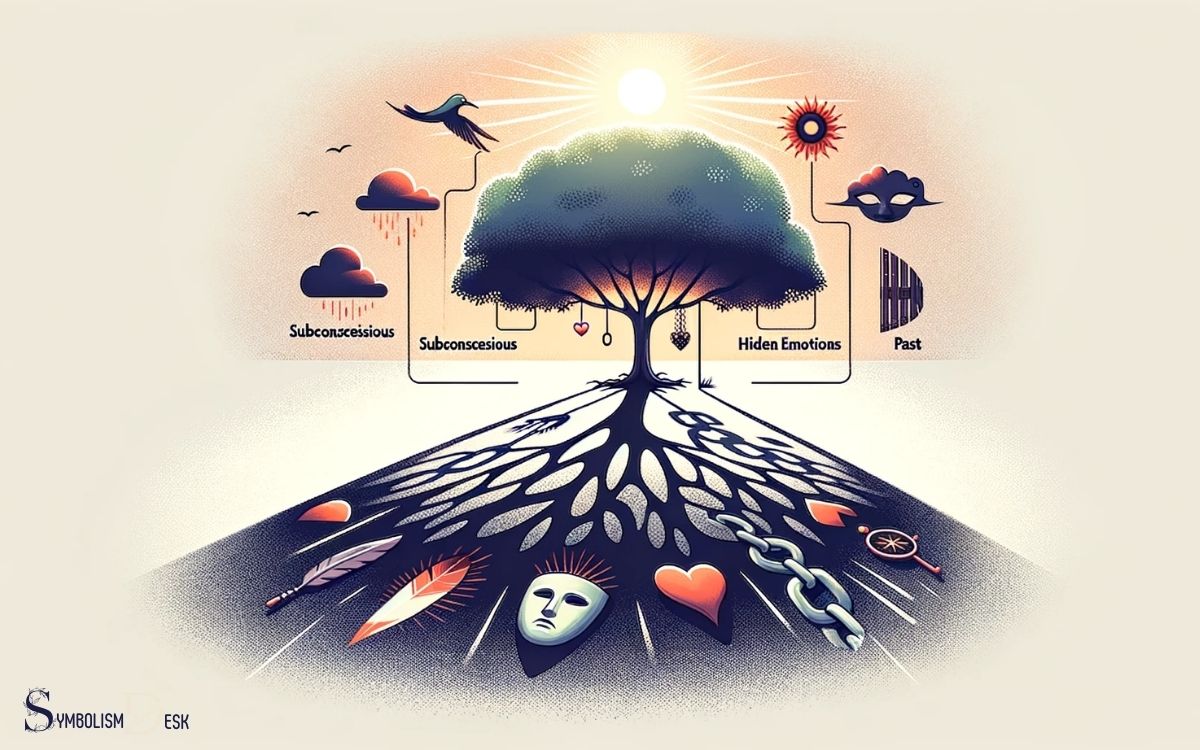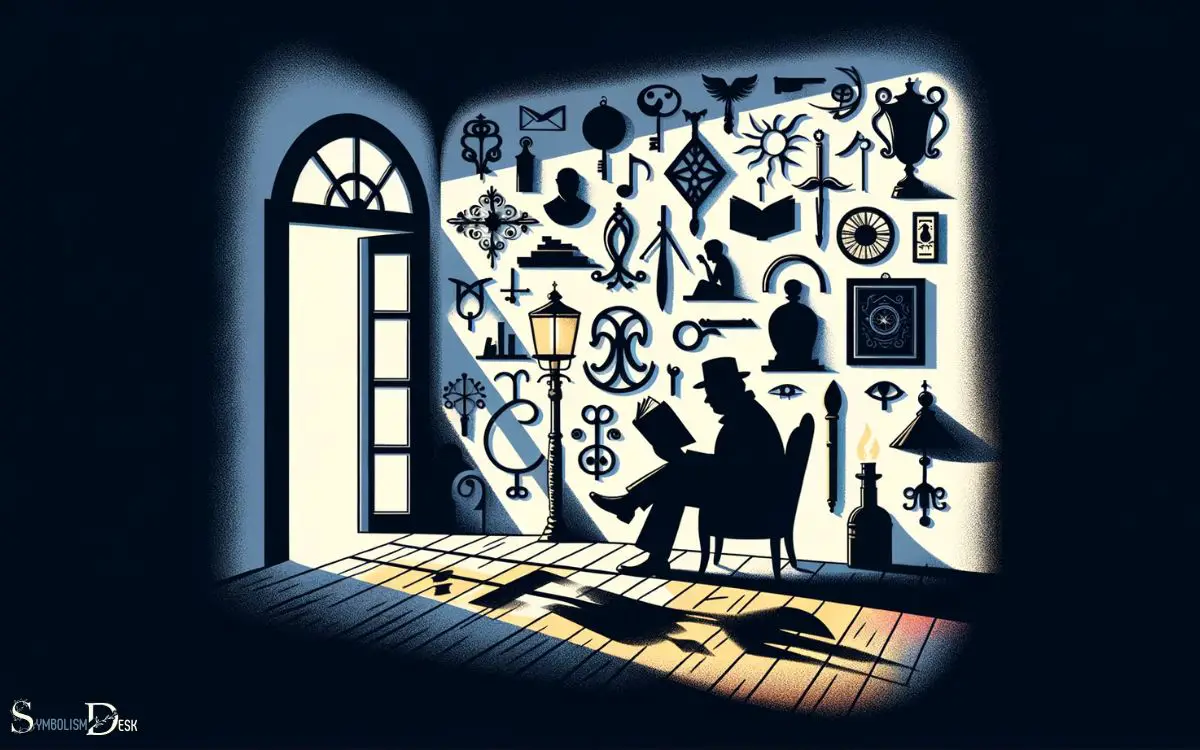What Does Symbolic Shadow Mean? Shortcomings!
The term ‘symbolic shadow’ refers to the unconscious aspect of the personality that contains repressed weaknesses, shortcomings, and instincts.
It is a concept introduced by Swiss psychiatrist Carl Jung, highlighting the shadow as a critical element in understanding the self and achieving personal growth.
This shadow encompasses the emotional and psychological traits that are not expressed on the surface but can have a significant impact on behavior and relationships.
The symbolic shadow is a core concept in Jungian psychology, representing the darker side of our personality. It is composed of the traits and behaviors we deem negative or undesirable. This aspect of our psyche is often hidden from our conscious awareness, but it plays a crucial role in shaping our thoughts and actions. Embracing and integrating the symbolic shadow is essential for personal growth and wholeness, as it allows us to confront and heal the aspects of ourselves that we have repressed or denied. The symbolic darkness meaning is a reminder that even our most challenging traits and experiences can offer valuable lessons and opportunities for transformation.
It is often projected onto others, leading to conflict or misunderstandings. It is essential to acknowledge and integrate for personal development.
For example, if someone has a tendency to be overly critical but does not recognize this trait in themselves, they may often find fault in others, not realizing this is a reflection of their shadow.
Exploring the symbolic shadow offers a pathway to deeper self-awareness and a more authentic life.

Key Takeaway
3 Interpretations of Symbolic Shadows
| Term | Definition | Example |
|---|---|---|
| Symbolic | Representing something abstract or intangible with an object, image, or idea | The dove is a symbolic representation of peace. |
| Shadow | A dark area or shape produced by an object blocking light | The shadow of a tree on the ground. |
| Symbolic Shadow | A metaphorical or conceptual darkness that represents an abstract idea or a hidden aspect of something | The “shadow” of a negative past event influencing a person’s behavior. |
Origins of Symbolic Shadow

Emerging from psychological theories and cultural symbolism, the origins of the symbolic shadow can be traced back to early philosophical and religious concepts.
In psychology, the term ‘shadow’ was popularized by Swiss psychiatrist Carl Jung, who described it as the unconscious aspect of the personality that the conscious ego does not identify in itself.
This concept has roots in ancient religious and philosophical traditions, where the shadow represents the hidden or repressed aspects of the self.
In various cultures, the shadow has been depicted in myths, folklore, and literature, often symbolizing the darker, unknown, or feared elements of human existence.
Over time, the symbolic shadow has evolved to encompass a wide range of meanings, from representing the personal unconscious to symbolizing collective or societal aspects that are hidden or suppressed.
Understanding Jung’s Perspective

Now, we will explore the concept of the symbolic shadow from the perspective of Carl Jung.
Understanding Jung’s perspective is crucial in comprehending the symbolic shadow’s definition, its significance in psychology, as well as its impact on personal and collective aspects of human experience.
Jung’s insights provide valuable depth and insight into the multifaceted nature of the symbolic shadow and its profound implications in the realm of psychology.
Symbolic Shadow Definition
Understanding Jung’s perspective on the symbolic shadow involves delving into the depths of the unconscious mind to comprehend the hidden aspects of the human psyche.
From Jung’s viewpoint, the symbolic shadow can be defined as:
- Unconscious Aspects: It represents the repressed or underdeveloped aspects of an individual’s personality.
- Archetypal Patterns: The symbolic shadow embodies archetypal patterns and traits that are often considered undesirable or unacceptable.
- Integration Process: Integrating the symbolic shadow involves acknowledging, accepting, and integrating these hidden aspects into conscious awareness.
- Personal Growth: Recognizing and working with the symbolic shadow is crucial for personal growth, self-discovery, and achieving psychological wholeness.
Understanding the symbolic shadow from Jung’s perspective offers profound insights into the human psyche, shedding light on the complexities of the unconscious mind and its influence on conscious behavior and experiences, which is essential in psychology.
Importance in Psychology
The significance of the symbolic shadow in psychology lies in its illumination of the unconscious aspects and archetypal patterns that shape an individual’s personality and behavior, as elucidated by Jung’s perspective.
Understanding this concept is crucial for delving into the depths of the human psyche and unraveling the complexities of human behavior.
By recognizing and integrating the symbolic shadow, individuals can embark on a journey of self-discovery, leading to a more holistic and balanced sense of self.
Jung’s perspective highlights the transformative potential of embracing one’s shadow, ultimately fostering personal growth and psychological wholeness.
Personal and Collective
Discussion of the symbolic shadow in psychology extends to its application in understanding personal and collective experiences through Jung’s perspective.
- Personal Understanding: The symbolic shadow represents repressed or unconscious aspects of an individual’s personality, including traits, desires, and fears that are not consciously acknowledged.
- Collective Understanding: In the collective sense, the shadow can manifest in societal attitudes, cultural prejudices, and historical traumas that are denied or suppressed by a group of people.
- Integration and Individuation: Jung believed that acknowledging and integrating the shadow is essential for personal growth and individuation, as well as for healing collective wounds.
- Archetypal Patterns: Understanding the symbolic shadow can provide insight into universal archetypal patterns that influence both personal and collective experiences.
Understanding the personal and collective implications of the symbolic shadow is crucial for delving into the unconscious symbolism it holds.
Unconscious Symbolism in the Shadow

Exploring the unconscious symbolism in the shadow allows for a deeper understanding of its significance in the human psyche.
By examining the symbolic meaning of the shadow, we can gain insight into the hidden aspects of the self and their impact on our thoughts, emotions, and behaviors.
Integrating the shadow becomes a crucial step in achieving psychological wholeness and personal growth.
Shadow as Unconscious Symbolism
One significant aspect of the symbolic shadow is its role as an unconscious representation of repressed thoughts, emotions, and desires within the human psyche.
This unconscious symbolism in the shadow can manifest in various ways, shedding light on aspects of the individual’s inner world that are often hidden from conscious awareness.
Here are some key points to consider:
- Symbolic Manifestations: The shadow can symbolize aspects of the self that have been suppressed or neglected, often materializing in dreams, fantasies, or projections onto others.
- Emotional Resonance: It carries emotional symbolism, encapsulating feelings of fear, shame, or anger that are not readily acknowledged in waking life.
- Unconscious Influence: The shadow exerts a powerful influence on behavior and interpersonal relationships, often leading to patterns of conflict or self-sabotage.
- Integration: Understanding the unconscious symbolism in the shadow is crucial for personal growth and psychological integration, as it allows individuals to confront and integrate disowned aspects of themselves.
Symbolic Meaning of Shadow
The symbolic meaning of the shadow involves the unconscious symbolism inherent in its representation.
The shadow, as a concept in psychology, represents the aspects of the self that are repressed, denied, or unknown to the individual. These unconscious elements may include traits, desires, or emotions that the conscious mind finds unacceptable or difficult to acknowledge.
Symbolically, the shadow embodies the darker, hidden aspects of the human psyche, encompassing both the negative and positive traits that are not readily apparent.
It serves as a reservoir for the parts of ourselves that we may find shameful or incompatible with societal norms, yet it also holds potential for creativity, vitality, and authenticity.
Understanding the symbolic meaning of the shadow allows individuals to explore and integrate these hidden aspects, leading to greater self-awareness and personal growth.
Integrating the Shadow
What implications does the unconscious symbolism in the shadow have for the process of integrating it into the conscious self?
Recognition: Understanding the unconscious symbols in the shadow requires recognition of repressed emotions, desires, and traits.
Acceptance: Integrating the shadow involves accepting the aspects of ourselves that we may find undesirable or threatening.
Exploration: Delving into the unconscious symbolism allows for exploration of the hidden aspects of the self and brings them into the light of consciousness.
Transformation: Integrating the shadow leads to transformation, as these unconscious symbols, once acknowledged and accepted, can be harnessed for personal growth and development.
Integrating the shadow involves a deep and often challenging process of self-discovery and self-acceptance, ultimately leading to a more integrated and authentic sense of self.
Symbolic Shadow in Personal Development
In personal development, the concept of the symbolic shadow plays a crucial role in understanding and addressing unconscious aspects of the self.
The symbolic shadow represents the repressed or denied parts of our personality, often stemming from childhood experiences, societal conditioning, and cultural influences.
Exploring the symbolic shadow in personal development involves recognizing and integrating these hidden aspects, allowing for a more holistic and authentic self-awareness.
By acknowledging and working with the symbolic shadow, individuals can confront their fears, insecurities, and unresolved emotions, leading to inner harmony and personal growth.
Understanding the symbolic shadow in personal development can pave the way for profound transformation and self-actualization.
This introspective journey can also have a significant impact on how individuals perceive and engage in their relationships with others.
Symbolic Shadow in Relationships
Exploring the symbolic shadow in relationships involves recognizing and integrating the repressed or denied aspects of personality, contributing to a deeper understanding of oneself and others in interpersonal dynamics.
This process can significantly impact the quality and depth of connections.
Here are four ways in which the symbolic shadow manifests in relationships:
- Projection: Unacknowledged traits in oneself are attributed to others.
- Conflict: Unresolved inner turmoil can lead to discord in relationships.
- Communication barriers: Suppressed thoughts and emotions hinder authentic interaction.
- Patterns of attraction: Unconscious desires can influence partner selection.
Understanding and addressing these manifestations of the symbolic shadow in relationships is essential for fostering healthy and fulfilling connections. Embracing and integrating the shadow allows for more authentic and harmonious relationships.
Embracing and Integrating the Shadow
The process of integrating the symbolic shadow in relationships involves acknowledging and reconciling the repressed aspects of one’s personality, fostering a deeper understanding of oneself and others.
Embracing the shadow means accepting the parts of ourselves that we may have ignored or denied, leading to a more authentic and balanced self. It requires courage to confront the shadow, as it may bring up uncomfortable emotions and truths about ourselves.
However, by embracing and integrating the shadow, individuals can experience personal growth and develop healthier relationships.
This process can also lead to increased compassion and empathy towards others, as it allows for a more comprehensive understanding of human nature.
Embracing the shadow is essential for personal development and building more meaningful connections with others.
Are Symbolic Shadows and Darkness Related in Their Meanings?
Shadows and darkness both possess a powerful symbolism in various cultures and literature. The symbolic meaning of darkness often represents the unknown, fear, or evil, while shadows can symbolize hidden aspects of the self or the unconscious. However, they are related in their deeper symbolic meanings of mystery and hidden truths.
Healing and Transforming the Shadow
Healing and transforming the symbolic shadow involves delving into the depths of our subconscious and addressing the unresolved wounds and traumas that have shaped our psyche. This process is essential for personal growth and inner peace.
Here are four crucial steps to healing and transforming the shadow:
- Acknowledgment: Acknowledge the existence of the shadow and its impact on your thoughts, emotions, and behaviors.
- Exploration: Explore the origins of your shadow aspects, including past experiences and conditioning that contributed to their development.
- Acceptance: Accept the shadow as a natural part of human existence, without judgment or shame.
- Integration: Integrate the shadow by incorporating its lessons and wisdom into your conscious self, leading to greater self-awareness and wholeness.
Conclusion
In conclusion, the symbolic shadow holds great significance in personal development and relationships. Understanding its origins and unconscious symbolism, as well as embracing and integrating it, can lead to healing and transformation.
The symbolic shadow, like a powerful force of nature, has the potential to deeply impact the psyche and guide individuals towards a more holistic and integrated sense of self.






